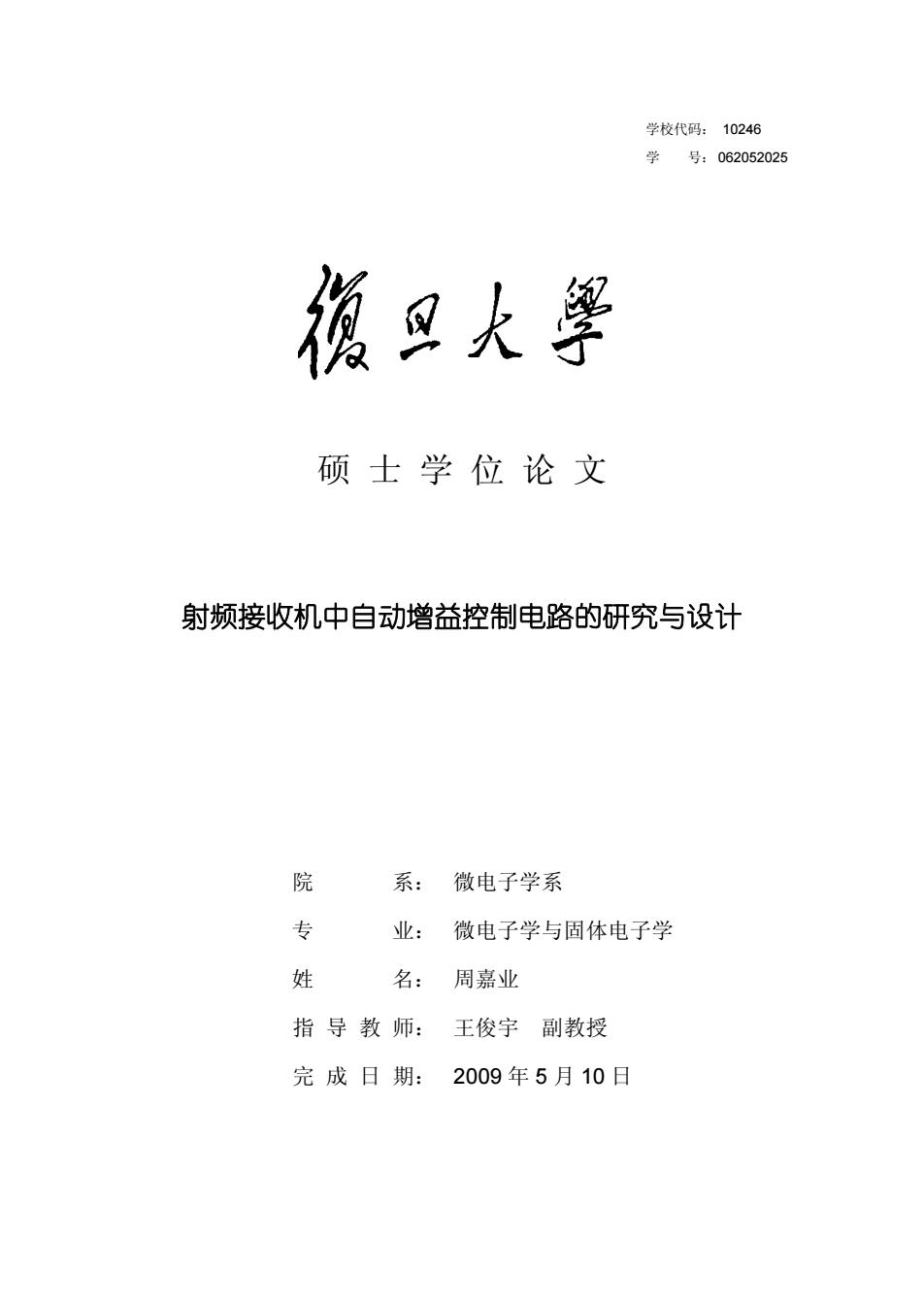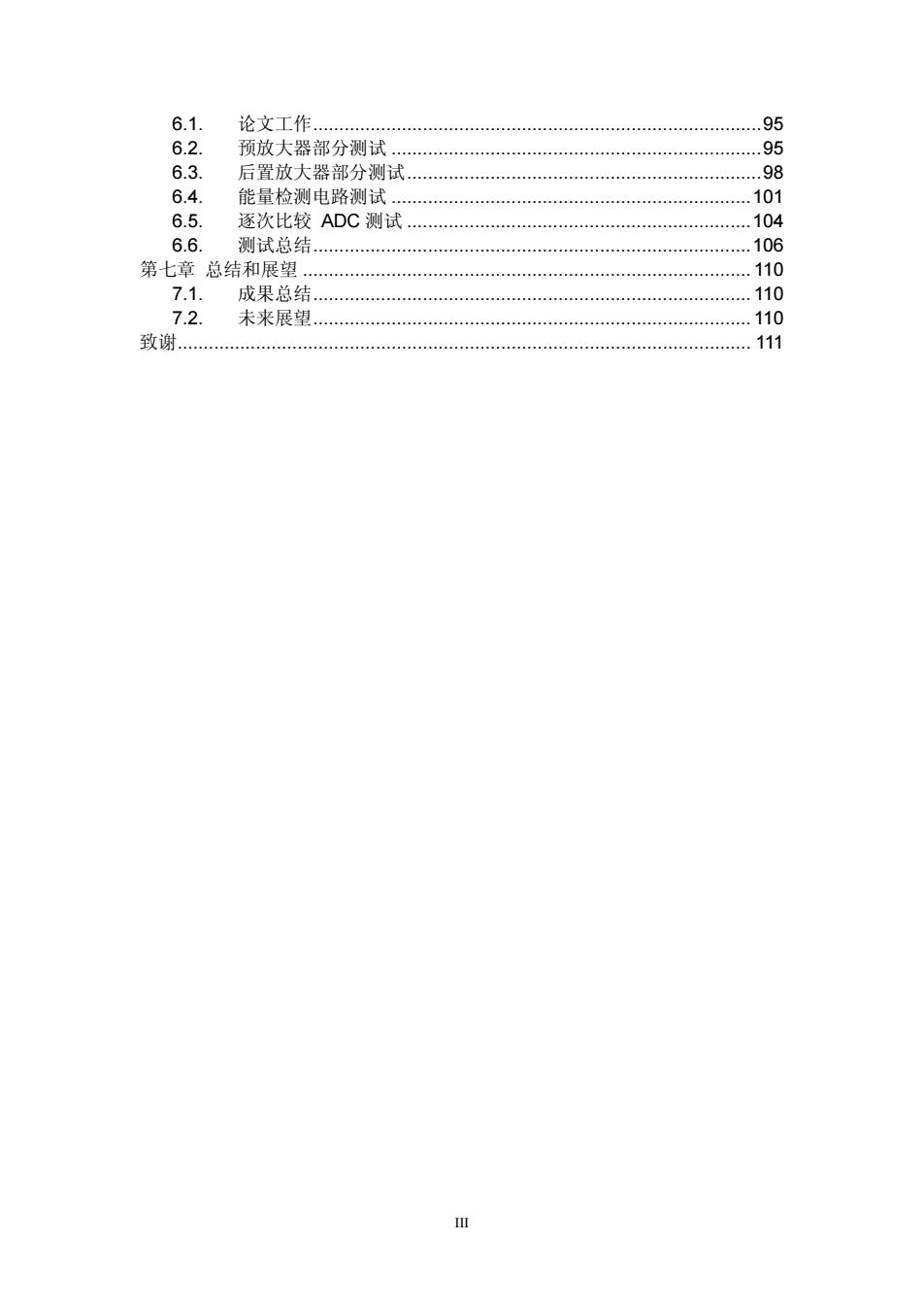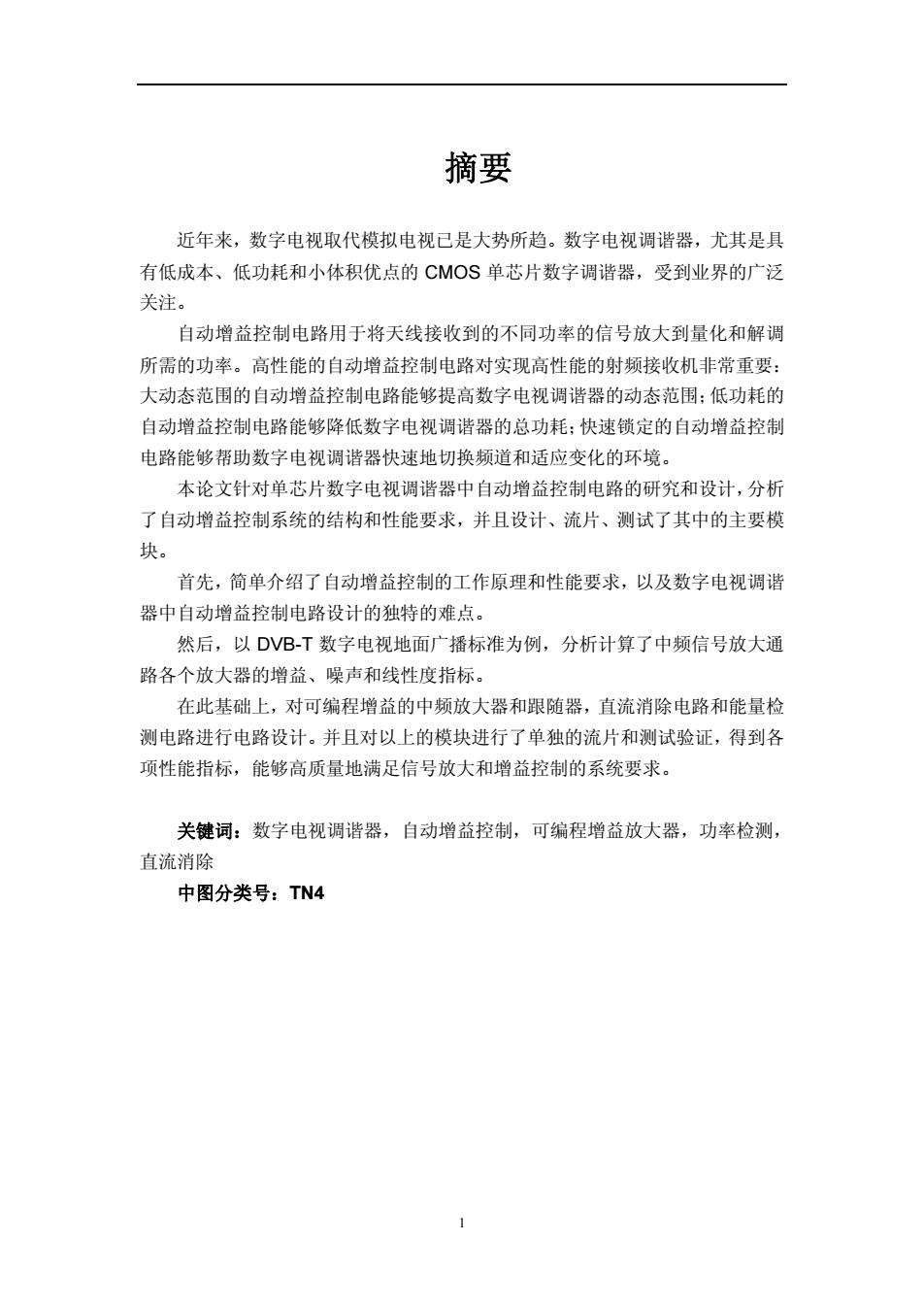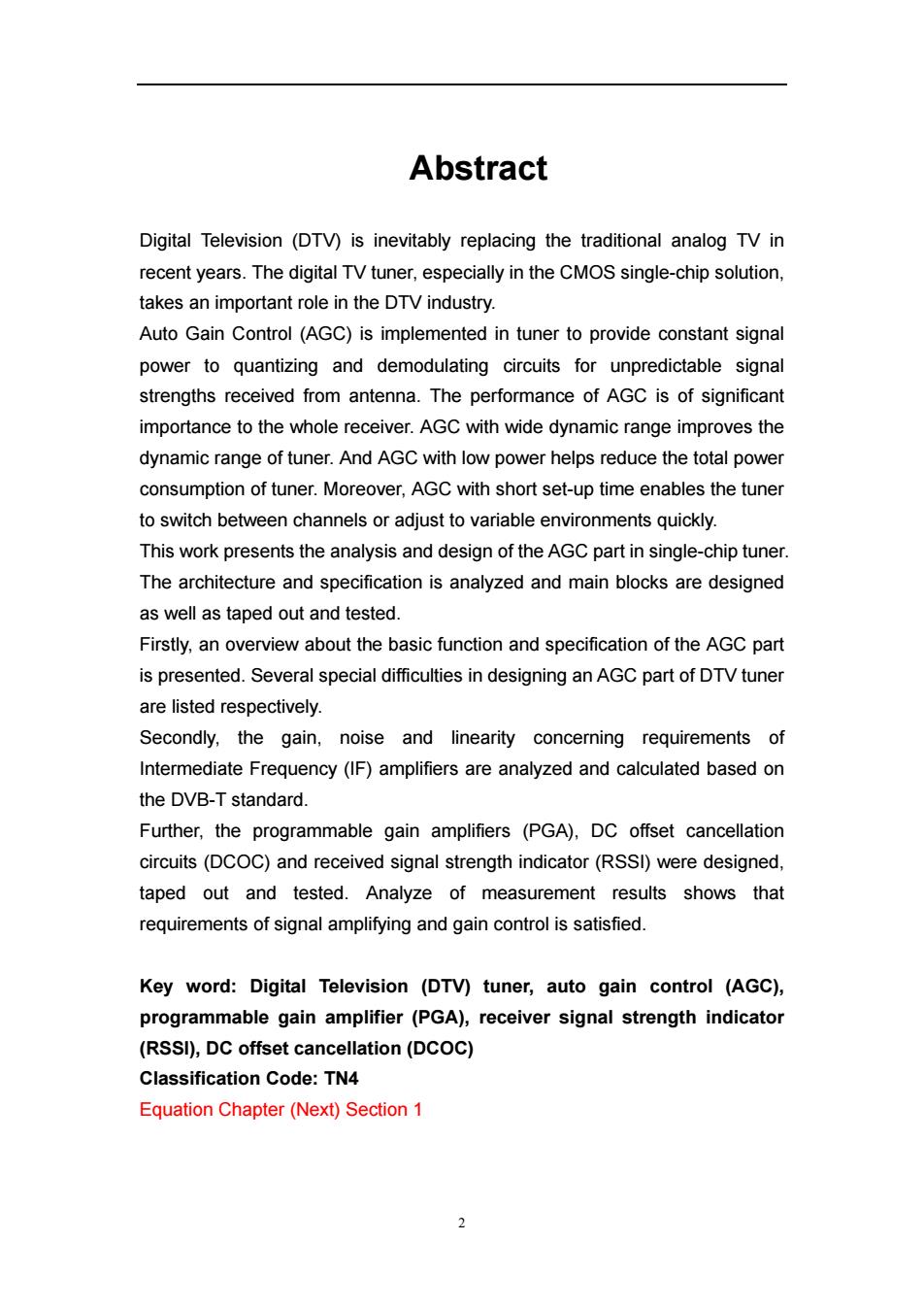
学校代码:10246 学 号:062052025 復旦大架 硕士学位论文 射频接收机中自动增益控制电路的研究与设计 院 系: 微电子学系 专 业: 微电子学与固体电子学 姓 名: 周嘉业 指导教师: 王俊宇 副教授 完成日期: 2009年5月10日
学校代码: 10246 学 号: 062052025 硕 士 学 位 论 文 射频接收机中自动增益控制电路的研究与设计 院 系: 微电子学系 专 业: 微电子学与固体电子学 姓 名: 周嘉业 指 导 教 师: 王俊宇 副教授 完 成 日 期: 2009 年 5 月 10 日

目录 目录… l 摘要.. 1 Abstract 2 第一章概述 .3 1.1 射频接收机中自动增益控制系统的作用 1.2 自动增益控制电路的性能要求.. .3 1.3. 自动增益控制电路的组成… 6 1.4 数字电视调谐器中自动增益控制电路的设计难点 ..6 1.5. 论文的研究内容及其贡献 8 1.6. 论文的组织结构. .10 参考文献 .10 第二章自动增益控制系统简介.…。 11 2.1. DVB-T标准简介 .11 2.2 接收机中自动增益控制的结构 .12 2.3. 线性度指标的计算 ..18 2.4. 中频放大器的增益估计 24 2.5. 中频放大器的性能指标总结 27 参考文献… 28 第三章可编程增益放大器和跟随器设计 30 3.1.可编程增益放大器和跟随器的性能指标 30 3.2. 开环和闭环结构的中频放大器 31 3.3. 中频放大器的输入级设计. 33 3.4. 中频放大器的输出级设计… 55 3.5. 中频放大器电路实现… 57 3.6 可编程增益的跟随器 63 参考文献 65 第四章直流消除电路设计. 67 4.1. 直流消除电路的基本功能.....… 67 4.2. 直流消除电路的模拟实现和混合信号实现 68 4.3. 直流消除电路的工作原理. 68 4.4. 利用密勒效应 69 4.5. 单级和多级直流消除电路 70 4.6. 直流消除电路的电路实现 72 4.7. 直流消除电路的性能分析. .75 参考文献 .81 第五章能量检测电路设计. 82 5.1. 数字自动增益控制环路组成… 82 5.2. 能量检测电路的设计..… 83 5.3. 逐次比较ADC的电路设计 90 参考文献… 94 第六章测试结果 95
II 目录 目录..................................................................................................................II 摘要..................................................................................................................1 Abstract............................................................................................................2 第一章 概述.....................................................................................................3 1.1. 射频接收机中自动增益控制系统的作用 .........................................3 1.2. 自动增益控制电路的性能要求........................................................3 1.3. 自动增益控制电路的组成...............................................................5 1.4. 数字电视调谐器中自动增益控制电路的设计难点...........................6 1.5. 论文的研究内容及其贡献...............................................................8 1.6. 论文的组织结构...........................................................................10 参考文献 ..................................................................................................10 第二章 自动增益控制系统简介....................................................................... 11 2.1. DVB-T 标准简介.......................................................................... 11 2.2. 接收机中自动增益控制的结构......................................................12 2.3. 线性度指标的计算 .......................................................................18 2.4. 中频放大器的增益估计 ................................................................24 2.5. 中频放大器的性能指标总结 .........................................................27 参考文献 ..................................................................................................28 第三章 可编程增益放大器和跟随器设计 ........................................................30 3.1. 可编程增益放大器和跟随器的性能指标 .......................................30 3.2. 开环和闭环结构的中频放大器......................................................31 3.3. 中频放大器的输入级设计.............................................................33 3.4. 中频放大器的输出级设计.............................................................55 3.5. 中频放大器电路实现....................................................................57 3.6. 可编程增益的跟随器....................................................................63 参考文献 ..................................................................................................65 第四章 直流消除电路设计..............................................................................67 4.1. 直流消除电路的基本功能.............................................................67 4.2. 直流消除电路的模拟实现和混合信号实现....................................68 4.3. 直流消除电路的工作原理.............................................................68 4.4. 利用密勒效应...............................................................................69 4.5. 单级和多级直流消除电路.............................................................70 4.6. 直流消除电路的电路实现.............................................................72 4.7. 直流消除电路的性能分析.............................................................75 参考文献 ..................................................................................................81 第五章 能量检测电路设计..............................................................................82 5.1. 数字自动增益控制环路组成 .........................................................82 5.2. 能量检测电路的设计....................................................................83 5.3. 逐次比较 ADC 的电路设计...........................................................90 参考文献 ..................................................................................................94 第六章 测试结果............................................................................................95

6.1. 论文工作.… 95 6.2. 预放大器部分测试 95 6.3 后置放大器部分测试 98 6.4. 能量检测电路测试 ,。。.0t000400400。。, 6.5 逐次比较ADC测试...... .104 6.6 测试总结 .106 第七章总结和展望 .110 7.1. 成果总结 .110 7.2 未来展望 110 致谢.… 111 Ⅲ
III 6.1. 论文工作......................................................................................95 6.2. 预放大器部分测试 .......................................................................95 6.3. 后置放大器部分测试....................................................................98 6.4. 能量检测电路测试 .....................................................................101 6.5. 逐次比较 ADC 测试 ..................................................................104 6.6. 测试总结....................................................................................106 第七章 总结和展望 ...................................................................................... 110 7.1. 成果总结.................................................................................... 110 7.2. 未来展望.................................................................................... 110 致谢.............................................................................................................. 111

摘要 近年来,数字电视取代模拟电视已是大势所趋。数字电视调谐器,尤其是具 有低成本、低功耗和小体积优点的CMOS单芯片数字调谐器,受到业界的广泛 关注。 自动增益控制电路用于将天线接收到的不同功率的信号放大到量化和解调 所需的功率。高性能的自动增益控制电路对实现高性能的射频接收机非常重要: 大动态范围的自动增益控制电路能够提高数字电视调谐器的动态范围:低功耗的 自动增益控制电路能够降低数字电视调谐器的总功耗:快速锁定的自动增益控制 电路能够帮助数字电视调谐器快速地切换频道和适应变化的环境。 本论文针对单芯片数字电视调谐器中自动增益控制电路的研究和设计,分析 了自动增益控制系统的结构和性能要求,并且设计、流片、测试了其中的主要模 块。 首先,简单介绍了自动增益控制的工作原理和性能要求,以及数字电视调谐 器中自动增益控制电路设计的独特的难点。 然后,以DVB-T数字电视地面广播标准为例,分析计算了中频信号放大通 路各个放大器的增益、噪声和线性度指标。 在此基础上,对可编程增益的中频放大器和跟随器,直流消除电路和能量检 测电路进行电路设计。并且对以上的模块进行了单独的流片和测试验证,得到各 项性能指标,能够高质量地满足信号放大和增益控制的系统要求。 关键词:数字电视调谐器,自动增益控制,可编程增益放大器,功率检测, 直流消除 中图分类号:TN4
1 摘要 近年来,数字电视取代模拟电视已是大势所趋。数字电视调谐器,尤其是具 有低成本、低功耗和小体积优点的 CMOS 单芯片数字调谐器,受到业界的广泛 关注。 自动增益控制电路用于将天线接收到的不同功率的信号放大到量化和解调 所需的功率。高性能的自动增益控制电路对实现高性能的射频接收机非常重要: 大动态范围的自动增益控制电路能够提高数字电视调谐器的动态范围;低功耗的 自动增益控制电路能够降低数字电视调谐器的总功耗;快速锁定的自动增益控制 电路能够帮助数字电视调谐器快速地切换频道和适应变化的环境。 本论文针对单芯片数字电视调谐器中自动增益控制电路的研究和设计,分析 了自动增益控制系统的结构和性能要求,并且设计、流片、测试了其中的主要模 块。 首先,简单介绍了自动增益控制的工作原理和性能要求,以及数字电视调谐 器中自动增益控制电路设计的独特的难点。 然后,以 DVB-T 数字电视地面广播标准为例,分析计算了中频信号放大通 路各个放大器的增益、噪声和线性度指标。 在此基础上,对可编程增益的中频放大器和跟随器,直流消除电路和能量检 测电路进行电路设计。并且对以上的模块进行了单独的流片和测试验证,得到各 项性能指标,能够高质量地满足信号放大和增益控制的系统要求。 关键词:数字电视调谐器,自动增益控制,可编程增益放大器,功率检测, 直流消除 中图分类号:TN4

Abstract Digital Television (DTV)is inevitably replacing the traditional analog TV in recent years.The digital TV tuner,especially in the CMOS single-chip solution, takes an important role in the DTV industry. Auto Gain Control(AGC)is implemented in tuner to provide constant signal power to quantizing and demodulating circuits for unpredictable signal strengths received from antenna.The performance of AGC is of significant importance to the whole receiver.AGC with wide dynamic range improves the dynamic range of tuner.And AGC with low power helps reduce the total power consumption of tuner.Moreover,AGC with short set-up time enables the tuner to switch between channels or adjust to variable environments quickly. This work presents the analysis and design of the AGC part in single-chip tuner. The architecture and specification is analyzed and main blocks are designed as well as taped out and tested. Firstly,an overview about the basic function and specification of the AGC part is presented.Several special difficulties in designing an AGC part of DTV tuner are listed respectively. Secondly,the gain,noise and linearity concerning requirements of Intermediate Frequency(IF)amplifiers are analyzed and calculated based on the DVB-T standard. Further,the programmable gain amplifiers (PGA),DC offset cancellation circuits(DCOC)and received signal strength indicator(RSSI)were designed, taped out and tested.Analyze of measurement results shows that requirements of signal amplifying and gain control is satisfied. Key word:Digital Television (DTV)tuner,auto gain control (AGC), programmable gain amplifier(PGA),receiver signal strength indicator (RSSI),DC offset cancellation(DCOC) Classification Code:TN4 Equation Chapter(Next)Section 1 2
2 Abstract Digital Television (DTV) is inevitably replacing the traditional analog TV in recent years. The digital TV tuner, especially in the CMOS single-chip solution, takes an important role in the DTV industry. Auto Gain Control (AGC) is implemented in tuner to provide constant signal power to quantizing and demodulating circuits for unpredictable signal strengths received from antenna. The performance of AGC is of significant importance to the whole receiver. AGC with wide dynamic range improves the dynamic range of tuner. And AGC with low power helps reduce the total power consumption of tuner. Moreover, AGC with short set-up time enables the tuner to switch between channels or adjust to variable environments quickly. This work presents the analysis and design of the AGC part in single-chip tuner. The architecture and specification is analyzed and main blocks are designed as well as taped out and tested. Firstly, an overview about the basic function and specification of the AGC part is presented. Several special difficulties in designing an AGC part of DTV tuner are listed respectively. Secondly, the gain, noise and linearity concerning requirements of Intermediate Frequency (IF) amplifiers are analyzed and calculated based on the DVB-T standard. Further, the programmable gain amplifiers (PGA), DC offset cancellation circuits (DCOC) and received signal strength indicator (RSSI) were designed, taped out and tested. Analyze of measurement results shows that requirements of signal amplifying and gain control is satisfied. Key word: Digital Television (DTV) tuner, auto gain control (AGC), programmable gain amplifier (PGA), receiver signal strength indicator (RSSI), DC offset cancellation (DCOC) Classification Code: TN4 Equation Chapter (Next) Section 1